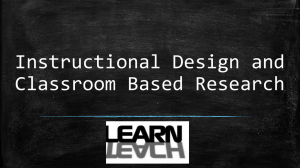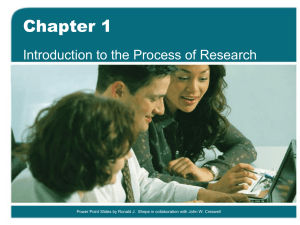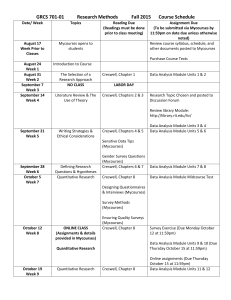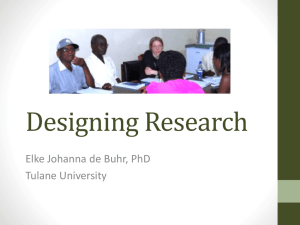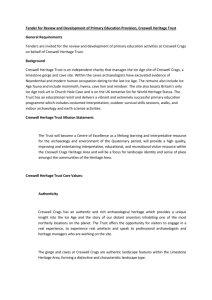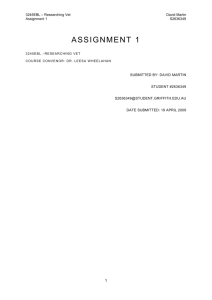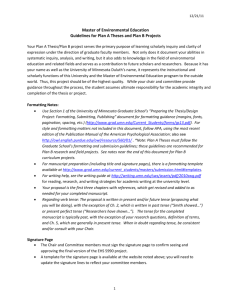EDU1005RedOwl
advertisement
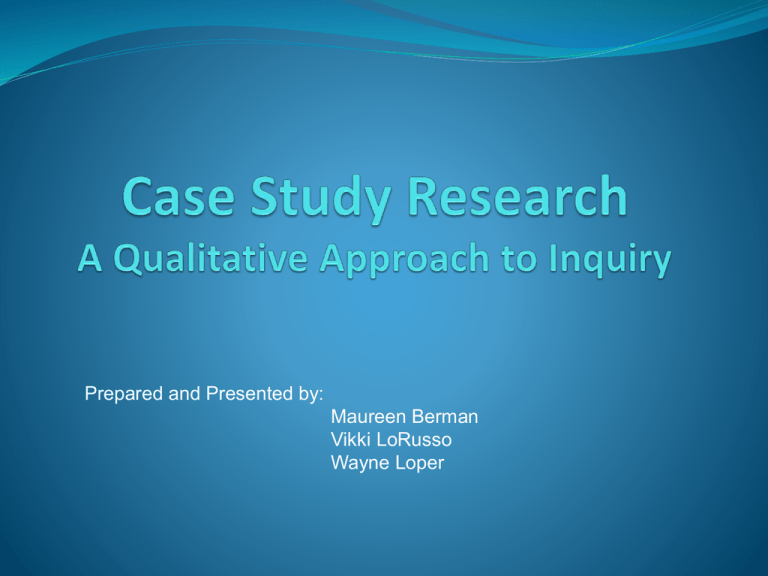
Prepared and Presented by: Maureen Berman Vikki LoRusso Wayne Loper Case Study Research Definition Case Study Research • involves the study of an issue explored through one or more cases within a bounded system (i.e., a setting, a context.) • a methodology, a type of design in qualitative research, or an object of study, as well as a product of the inquiry. (Creswell, 2007, p. 73) Case Study Research (Cont’d) Case Study Research includes In-depth Study of a Single Case or Collective Case Bounded System – the ‘case’ selected for study has boundaries often bounded by time and place Multiple Sources of Information – the use of many different sources of information to prove ‘depth’ to the case Case Description – stating the “facts about the case as recorded by the investigator. This is the first step of analysis of data in a qualitative case study. Case Based Themes - the researcher analyzes the data for specific theme’s, aggregating information into large clusters of ideas and providing details that support the themes. (Creswell, 2007, p. 73) Case Study Research (Cont’d) Bounded System •Time—6 months of data collection •Place—situated on a single campus •Single Case—campus community •The reactions of the groups on campus Multiple Sources of Information •Initial Interviews Campus administrators, students, newspaper reporters •Expanded Interviews Campus informants and gathered observational data, documents and audio visual materials Case Description •Narrative structure to describe details including edited quotes from the informants and stating the interviewers interpretations of the events •Considerable time describing the setting for the case Case Based Themes •Denial •Fear •Safety •Retriggering •Campus planning (Preparedness) (Creswell, 2007, pp.357-374) Case Study Research (Cont’d) Types of Case Studies (Creswell, 2007, p. 74) Distinguished by the size of the bounded case Does the case involve: • An individual • Several individuals • A group • An entire program • An activity Distinguished by the intent of the case analysis • Single Instrumental Case Study –the focus is on the specific issue and a bounded case is selected to illustrate the issue. (i.e., the gunman case study) (Stake, 1995, as cited in Creswell, 2007, p. 74) • Collective Case Study –the focus is on an issue but multiple case studies are examined to illustrate the issue • Intrinsic Case Study –the focus is on the case because it presents an unusual or unique situation (Stake, 1995, as cited in Creswell, 2007, p. 74) Case Study Research (Cont’d) Procedures for Conducting a Case Study (Stake, 1995, Creswell, 2007, pp. 74-75) Determine appropriateness • clearly definable boundaries that seeks to provide an in depth understanding of the case(s) Identify the case or cases • single or collective, multi-sited or with-in site, Data collection • very extensive, drawing on multiple sources of information (observations, interviews, documents, audiovisual materials) Type of data analysis • Holistic Analysis – examine the entire case and present the description, themes, and interpretations related to the whole case (Yin, 2003, as cited in Creswell, 2007, p. 75) • Embedded Analysis – select one analytic aspect of the case for presentation (i. e., The gunman case study involved tracing the campus response to a gunman for two weeks immediately following the near tragedy on campus.) (Stake, 1995, as cited in Creswell, 2007, p. 75) • Detailed Description – stating the facts as recorded by the investigator (Stake, 1995, as cited in Creswell, 2007, p. 75) • Analysis of Themes - analyzes the data for specific themes aggregating information into large clusters of ideas and providing details that support the themes not to generalize about the case but to better understand the complexity of the case (Yin, 2003, as cited in Creswell, 2007, p. 75) Case Study Research (Cont’d) Procedures for Conducting a Case Study (Cont’d) Interpretive phase: Identifying the meaning of the case • Direct Interpretation - look at a single instance and draw meaning from it without looking for multiple instances of it: pulling the data apart (analysis) and putting it back together (synthesis) in a meaningful way • Establish Patterns – establish patterns and looks for a correspondence between two or more categories which can be displayed in a table format to establish a small number of categories • Develop Naturalistic Generalizations – from analyzing the data, generalizations that people can learn from the case either for themselves or to apply to a population of cases an investigator undertakes a case study to make the case understandable (Stake, 1995, as stated in Creswell, 2007, p. 163) Case Study Research (Cont’d) Challenges in Developing a Case Study • Identifying the Case or Issue • Is the Issue Worth Studying? • Has the Issue any Value? • What Type of Case Study Will You Conduct? • Single or Multiple Cases? • What Is the Most Useful and Promising? • Data Collection • Establish a Rationale • Is Enough Information Available? • Boundaries • How Will You Bound Your Case Study? (Creswell, 2007, pp. 75-76) Case Study Research (Cont’d) Challenges in Developing a Case Study • What Is the Intent of Your Study? • Will it Generate Theory? • Will it Be Analytic in Nature? • Will it Display Cross Case Comparisons? • Will it Display Within Case Comparisons? (Creswell, 2007, pp. 75-76) Case Study Research (Cont’d) Case Study Structure • Overall Rhetorical Structure • Short Descriptive Opening Statement • Identify the Issue, Purpose and Method • Extensive Body of Uncontested Data • Presentation of Key Ideas • Investigation of the Issues • Assertions • Closing Statement • Embedded Rhetorical Structure • What Specific Structures Does the Researcher Use to Present the Study? Approach Proper Balance (Stake, 1995, as cited in Creswell, 2007, pp. 195-196) Research Approach Comparison A Case Study Versus a Narrative Study (Creswell, 2007, pp. 225-226) Case Study Narrative Study Research Approach Clearly Identifiable Case is Examined often Illustrating the Complexity of an Issue The Life of a Single Individual Purpose Statement Bounded, Single or Collective Case, Event, Process, Program, Individual Stories, Epiphanies, Lived Experiences, Chronology Questions What Happened? Differing Approaches, Intents and Structures What Stories Can be Told and What Theories Relate to this Individual’s Life Data Collection Documents, Records, Interviews, Observation and Artifacts Documents, Interviews, Observations and Archived Materials Data Analysis and Describe the Case and Context, Establish Representation Themes and Patterns, Develop Naturalistic Generalizations Describe Experiences, Identify Stories, and Interpret the Larger Meaning Written Report Present Narration Focusing on Process, Theories, and Features of the Life Present In-Depth Picture Using Narrative, Tables, and Figures Research Approach Comparison A Case Study Versus a Phenomenological Study (Creswell, 2007, pp. 225-227) Case Study Phenomenological Study Research Approach Clearly Identifiable Case is Examined often Illustrating the Complexity of an Issue Examine a psychological concept, a phenomenon. Purpose Statement Bounded, Single or Collective Case, Event, Process, Program, Individual Describe; Experiences; Meaning; Essence Questions What Happened? Differing Approaches, Intents and Structures What was experienced? How did they experience it? What meaning did they ascribe to it? Data Collection Documents, Records, Interviews, Observation and Artifacts Extensive interviews with five to twenty-five people. Often, multiple interviews with the same individuals. Data Analysis and Representation Describe the Case and Context, Establish Themes and Patterns, Develop Naturalistic Generalizations Analyze for significant meanings and statements. Look for significant statements or quotes about their meanings. Written Report Present In-Depth Picture Using Narrative, Tables, and Figures Cluster into broader theme. Describe what (textual) they experienced; how (structural) they experienced. Combine the two to describe the essence of their experience. Research Approach Comparison A Case Study Versus a Grounded Theory Study (Creswell, 2007, pp. 225-, 227-228) Case Study Grounded Theory Study Research Problem Clearly Identifiable Case is Examined often Illustrating the Complexity of an Issue Moves beyond a description of a phenomenon, develops a theory of practice Purpose Statement Bounded, Single or Collective Case, Event, Process, Program, Individual Generate; Develop; Propositions; Process; Substantive theory Questions What Happened? Differing Approaches, Intents and Structures What theory explains the phenomenon? What were those experiences? What caused them? What strategies did they use to cope with them? What were the consequences of their strategies? What specific interaction issues and larger conditions influenced their strategies? Data Collection Documents, Records, Interviews, Observation and Artifacts Conduct interviews with between 20-30 people. Data Analysis and Representation Describe the Case and Context, Establish Themes and Patterns, Develop Naturalistic Generalizations Procedure for developing categories of info (open coding); interconnecting the categories (axial coding); building a story that connects the categories (selective coding); ends with a discursive set of theoretical propositions. (Strauss & Corbin, 1990, as cited in Creswell, p. 228) Written Report Present In-Depth Picture Using Narrative, Tables, and Figures Discusses the relationship of the theory to other existing knowledge and implications of the theory for future research and practice. (May, 1986, as cited in Creswell, p. 190) Research Approach Comparison A Case Study Versus an Ethnographical Study (Creswell, 2007, pp. 225, 228-229) Case Study Ethnographical Study Research Problem Clearly Identifiable Case is Examined often Illustrating the Complexity of an Issue Generating a theory grounded in the data. Purpose Statement Bounded, Single or Collective Case, Event, Process, Program, Individual Culture-sharing group; Culture behavior and language; Culture portrait; Cultural themes Questions What Happened? Differing Approaches, Intents and Structures How did this incident produce predictable role performance within affected groups? Data Collection Documents, Records, Interviews, Observation and Artifacts Extended time interviews and observations. 1) Build rapport with community participation; 2) Observe over time predictable activities, behavior of roles 3) rely on interview, observations, newspaper accounts. Data Analysis and Representation Describe the Case and Context, Establish Themes and Patterns, Develop Naturalistic Generalizations Written Report Present In-Depth Picture Using Narrative, Tables, and Figures Interpret and make sense of the findings to see how the culture works. Then present narrative presentation enhanced with tables, figures and sketches. The report is a summary of the analysis and interpretation. References Cohen, L., Manion, L., & Morrison, K. (2007). Research methods in education (6th ed.). New York: Routledge. Creswell, J. W. (2007). Qualitative inquiry and research design: Choosing among five approaches (2nd ed.). Thousand Oaks, CA: Sage Publications.
